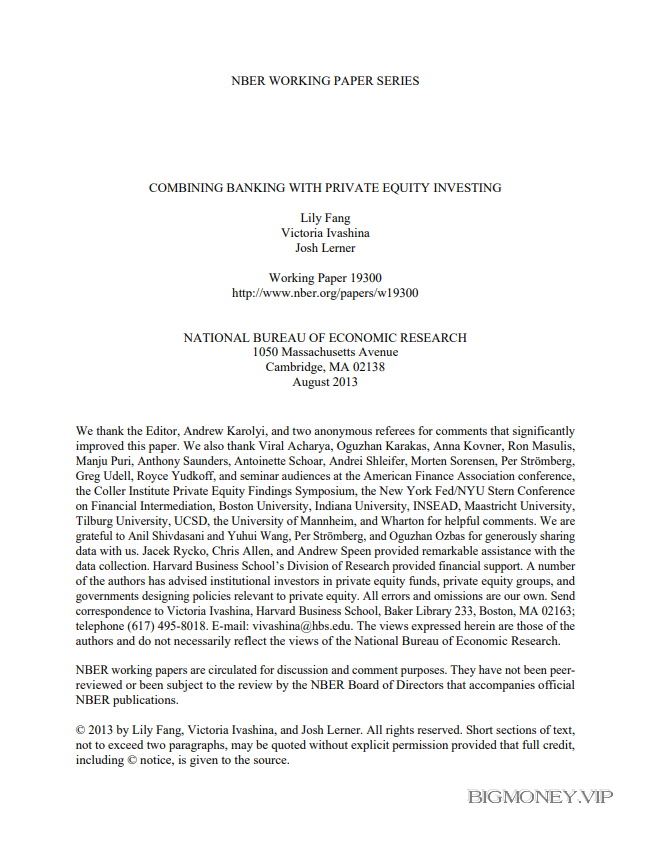COMBINING BANKING WITH PRIVATE EQUITY INVESTING by Lily Fang, Victoria Ivashina, Josh Lerner

1. Banks and Private Equity
Private equity firms use privately raised capital to buy stakes in companies and hope to realize a
profit when they sell (or exit) these investments. The equity capital of private equity funds is raised from
limited partners (LPs); investment decisions are made by general partners (GPs). In the case of a bank-
affiliated private equity fund, the parent bank often acts as an anchor LP to the fund, contributing as much
as 50% of the fund’s equity (Hardymon, Lerner, and Leamon (2004)).
In addition to equity, a typical private equity transaction includes several layers of debt. Over the
past two decades, debt represented on average 60-70% of the capital structure in leveraged buyouts and
reached as high as 80% in 2006 and early 2007. Since the mid-1980s, syndicated bank debt has been an
important source of funding in this market. Although the loan issued in conjunction with a transaction
typically has recourse only to the target (portfolio firm), the private equity firm is referred to as the
“financial sponsor”. Figure 2, Panel A illustrates a typical transaction done by a stand-alone (i.e., non-
bank-affiliated) private equity group. The private equity sponsor (Blackstone, in this case) invests in the
equity stake of the target company; the bank (Citi in this case) arranges the debt used in the transaction. In
contrast, Panel B of Figure 2 illustrates a bank-affiliated transaction. Here, the private equity sponsor is
Goldman Sachs Capital, a subsidiary of Goldman Sachs. Thus, the difference between a bank-affiliated
private equity deal and a stand-alone deal is whether the private equity sponsor has a bank (holding
company) as a parent. In our analysis, we use a zero-one variable BANK AFFILIATED to indicate this
difference. Our measure of affiliation is independent of the size of the parent bank’s equity contribution
as a LP.
As noted above, the parent bank can act as a lead bank in the lending syndicate. Panel C of
Figure 2 illustrates this scenario. Here, the private equity sponsor is Goldman Sachs Capital, a subsidiary
of Goldman Sachs. But in addition, Goldman Sachs (the parent bank) leads the loan syndicate. We use a
zero-one dummy PARENT FINANCED to indicate these deals. Of the bank-affiliated deals in our sample,
roughly one-third is parent financed. Notice that Panels A, B, and C of Figure 2 illustrate the three
possible categories of transactions; by definition, it is not possible for a stand-alone private equity deal to
be parent financed.
In general, bank-affiliated transactions are similar to stand-alone transactions in many respects,
such as the target industry, deal characteristics, and the investors’ evaluation processes. We provide
evidence on this similarity in the next section. In addition, we conducted interviews with a number of
senior private equity professionals from four different firms who have worked in bank-affiliated as well
as stand-alone private equity firms. The consensus emerging from these interviews is that the transactions
undertaken by bank-affiliated and large independent private equity groups are similar: the target industry,
characteristics, and the investors’ evaluation processes do not differ materially. In fact, these investors
COMBINING BANKING WITH PRIVATE EQUITY INVESTING by Lily Fang, Victoria Ivashina, Josh Lerner




